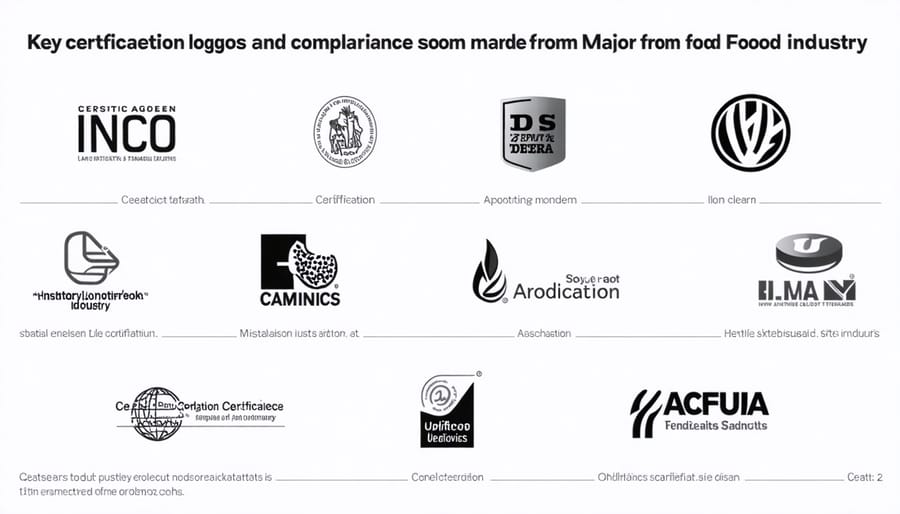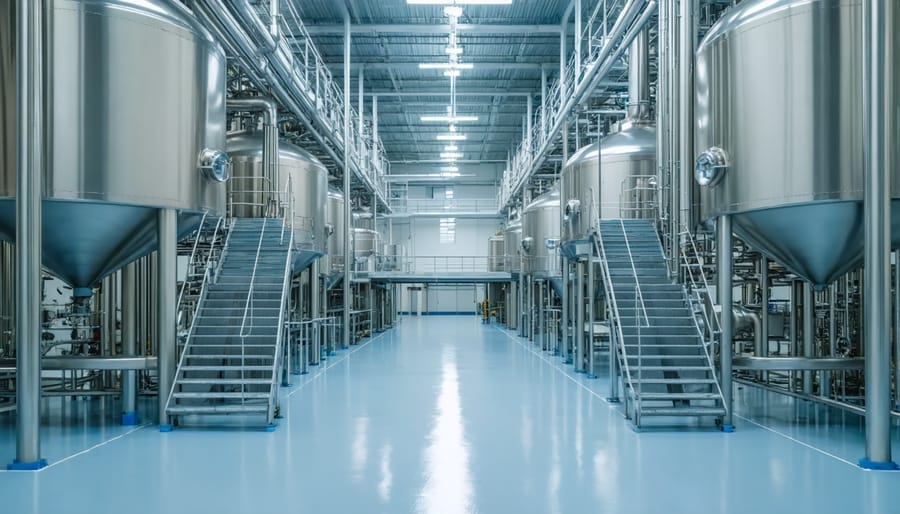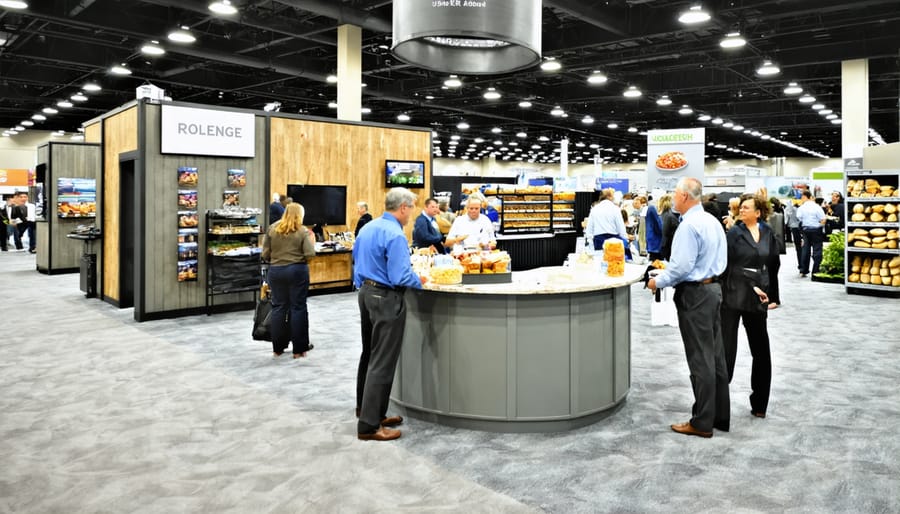Food industry associations shape the critical intersection of construction standards and food facility design, driving innovation and compliance across the built environment. These organizations establish crucial guidelines that influence everything from commercial kitchen layouts to food processing plant specifications, impacting billions in construction investments annually.
Leading associations like the International Association for Food Protection (IAFP) and the Institute of Food Technologists (IFT) collaborate with construction professionals to develop building standards that ensure food safety, operational efficiency, and regulatory compliance. Their technical committees provide invaluable insights into specialized construction requirements, from cleanroom specifications to hygiene-focused material selection.
For construction professionals, understanding these associations’ standards and certification programs is paramount. They offer specialized training in food facility construction, access to cutting-edge research on building materials and systems, and networking opportunities with food industry experts. This knowledge directly impacts project success, ensuring facilities meet both current regulations and future industry needs while maintaining the highest standards of food safety and operational excellence.
Key Food Industry Associations Shaping Modern Construction
Regional vs. International Associations
Food industry associations operate at both regional and international levels, each playing distinct roles in shaping construction standards and regulations. Regional associations typically focus on local building codes, zoning requirements, and market-specific challenges, providing targeted support for area-specific compliance issues. These organizations often maintain close relationships with local authorities and better understand regional construction practices and cultural considerations.
International associations, conversely, establish broader guidelines and standards that influence global construction practices in the food industry. They facilitate cross-border knowledge sharing and promote standardization across different markets, particularly important for multinational food processing facilities and distribution centers. Organizations like the Global Food Safety Initiative (GFSI) and the International Association for Food Protection (IAFP) develop comprehensive standards that often become benchmarks for regional associations.
The interplay between regional and international associations creates a robust framework for construction standards. While international bodies provide overarching principles and best practices, regional associations adapt these guidelines to local contexts, ensuring practical implementation. This dual-level approach particularly benefits construction professionals working on international projects, as it helps navigate both global standards and local requirements.
For construction firms, understanding the relationship between these associations is crucial for project success, especially when designing and building food processing facilities that must meet both local and international compliance standards.
Certification and Compliance Bodies
Several prominent certification and compliance bodies play crucial roles in establishing and maintaining food facility construction standards. The National Sanitation Foundation (NSF) sets comprehensive guidelines for food-grade materials, equipment specifications, and facility design requirements. Their standards are widely recognized and often referenced in building codes across North America.
The American Society for Testing and Materials (ASTM) develops technical standards for construction materials used in food processing facilities, including specific requirements for flooring, wall systems, and drainage components. These standards ensure materials can withstand rigorous cleaning protocols while maintaining structural integrity.
The International Association for Food Protection (IAFP) contributes valuable insights into facility design that promotes food safety, working closely with architects and engineers to develop best practices for construction projects. Their guidelines often influence local health department requirements and building permits for food facilities.
The Safe Quality Food Institute (SQFI) certification program includes detailed facility requirements that impact construction decisions, from air handling systems to traffic flow patterns. Similarly, the British Retail Consortium (BRC) Global Standards provide specific building requirements that many international food companies must meet to maintain certification.
These organizations regularly update their standards to reflect technological advances and emerging food safety challenges, making it essential for construction professionals to maintain current knowledge of certification requirements and compliance standards.

Design Standards and Building Requirements

Food Safety Construction Guidelines
Food industry construction must adhere to stringent safety guidelines established by regulatory bodies and industry associations. These requirements encompass critical areas including material selection, spatial layout, and mechanical systems to ensure safe food production and handling environments.
Wall and floor surfaces must be constructed using non-porous, easy-to-clean materials resistant to chemical cleaning agents. Approved materials typically include food-grade stainless steel, epoxy-coated concrete, and specialized antimicrobial surfaces. Floors require proper drainage slopes (minimum 1:100) and cove bases to prevent water accumulation and facilitate thorough cleaning.
Ventilation systems demand careful consideration, with separate zones for raw and ready-to-eat products to prevent cross-contamination. HVAC systems must maintain positive air pressure in processing areas and include HEPA filtration where necessary. Temperature and humidity control systems should be designed with redundancy to ensure continuous operation.
Plumbing installations require backflow prevention devices, proper pipe materials, and strategic placement of hand-washing stations. The facility layout must follow workflow patterns that separate raw materials from finished products, incorporating transition zones and hygiene stations at critical control points.
Building envelope design must prevent pest entry and environmental contamination. This includes sealed dock levelers, air curtains at entrances, and properly designed roof systems to prevent water intrusion. Lightning protection and proper grounding systems are essential for equipment safety and product protection.
Construction teams must implement contamination control measures during renovation projects in active facilities, including temporary containment barriers and enhanced cleaning protocols. Regular inspections and documentation of construction materials and methods ensure compliance with food safety standards throughout the building process.
Energy Efficiency Standards
Food industry facilities face increasingly stringent energy efficiency requirements as sustainability becomes a core focus in modern construction. Leading food industry associations have established comprehensive frameworks that guide the implementation of sustainable design practices and energy management systems in food processing and storage facilities.
These standards typically mandate specific thermal envelope requirements, HVAC system efficiency ratings, and lighting power density limitations. Key requirements include minimum R-values for wall and roof assemblies, advanced building automation systems for optimal energy consumption, and the integration of energy-efficient processing equipment.
Many associations now require facilities to implement energy monitoring and verification systems that track real-time consumption patterns. This data-driven approach enables facility managers to identify opportunities for optimization and ensure compliance with energy performance targets. Modern food facilities must also incorporate renewable energy solutions where feasible, with many associations setting minimum requirements for on-site generation or renewable energy procurement.
Building envelope design must address both energy efficiency and food safety concerns. This includes specifications for proper insulation systems that maintain temperature control while preventing condensation issues that could compromise product safety. Mechanical systems must be designed to achieve optimal energy performance while maintaining strict environmental conditions required for food processing and storage.
The standards also emphasize the importance of commissioning and regular performance verification to ensure that energy-efficient systems operate as intended throughout the facility’s lifecycle. This comprehensive approach helps food industry facilities reduce operational costs while meeting increasingly stringent environmental regulations.
Networking and Knowledge Exchange
Annual Conferences and Trade Shows
The food industry calendar features several prominent industry events and conferences that bring together construction professionals, food manufacturers, and facility designers. The International Food Technology (IFT) Annual Meeting & Food Expo stands out as the largest gathering, attracting over 20,000 attendees and featuring innovative construction solutions for food processing facilities.
The Global Food Safety Conference (GFSC) provides crucial insights into facility compliance and construction requirements, while the Process Expo focuses specifically on plant design and equipment installation standards. These events offer valuable networking opportunities and showcase the latest developments in food-grade building materials and sanitary design principles.
Regional trade shows like the Northwest Food Show and Southeast Food Processing Conference address location-specific construction challenges and regulatory requirements. Construction professionals can participate in specialized workshops covering topics such as cleanroom design, HVAC systems for food processing, and contamination control measures.
Many associations also host focused symposiums throughout the year, addressing specific segments like dairy processing facilities, meat packing plants, and beverage production facilities. These events typically feature expert panels, facility tours, and technical presentations on construction best practices, making them essential resources for industry professionals seeking to stay current with food facility construction standards.

Professional Development Opportunities
Food industry associations offer extensive professional development opportunities that enhance expertise in construction-specific areas of food facility design and implementation. These organizations provide specialized certification programs focusing on critical aspects such as food safety construction requirements, sanitary design principles, and regulatory compliance.
The Food Processing Suppliers Association (FPSA) delivers targeted training programs on equipment installation standards and facility optimization. Their certification courses cover essential topics including hygienic welding techniques, drainage system design, and cleanroom construction specifications. Similarly, the International Association for Food Protection (IAFP) offers advanced workshops on building envelope systems that maintain food safety integrity.
Construction professionals can access specialized courses in food plant construction through the American Society of Baking (ASB), which focuses on bakery facility design and construction requirements. These programs typically combine classroom instruction with hands-on training, ensuring participants gain practical experience alongside theoretical knowledge.
Many associations also provide online learning platforms featuring webinars, virtual workshops, and self-paced courses. These resources allow construction professionals to stay current with evolving industry standards while maintaining flexible schedules. Additionally, completion of these programs often leads to recognized certifications that demonstrate expertise in food facility construction to potential clients and employers.
Regular attendance at association-sponsored training events also creates valuable networking opportunities with industry experts and peers, facilitating knowledge exchange and professional growth.
Future Trends and Innovation
As the food industry continues to evolve, emerging developments in facility construction are reshaping how food industry associations approach their guidelines and recommendations. Smart technology integration has become a cornerstone of modern food facility design, with associations increasingly emphasizing the implementation of IoT sensors for real-time monitoring of critical parameters such as temperature, humidity, and air quality.
Sustainability requirements are becoming more stringent, with associations developing new standards for energy-efficient building systems and waste reduction protocols. Many organizations are now requiring LEED certification or equivalent green building standards as baseline requirements for new construction projects. This shift reflects both environmental concerns and operational cost considerations.
Automation and robotics are driving significant changes in facility design requirements. Associations are updating their guidelines to accommodate automated storage and retrieval systems (AS/RS), autonomous guided vehicles (AGVs), and other advanced manufacturing technologies. These changes necessitate different approaches to floor plans, ceiling heights, and utility infrastructure.
Food safety remains paramount, with associations incorporating new requirements for antimicrobial building materials, advanced air filtration systems, and enhanced sanitation capabilities. The COVID-19 pandemic has accelerated the adoption of touchless technologies and improved ventilation standards, which are now being codified into association guidelines.
Looking ahead, food industry associations are expected to focus on several key areas:
– Integration of artificial intelligence for facility management and food safety monitoring
– Implementation of blockchain technology for supply chain transparency
– Advanced materials that improve building performance and food safety
– Modular construction techniques for rapid facility deployment
– Enhanced cybersecurity requirements for smart building systems
These trends are reshaping both new construction and renovation projects in the food industry, requiring construction professionals to stay current with evolving association standards and technological capabilities.
Food industry associations have emerged as pivotal stakeholders in modern construction, bridging the gap between culinary requirements and building design. Their influence extends far beyond traditional food safety guidelines, shaping the very foundation of how we approach commercial kitchen design, food processing facilities, and restaurant construction projects.
These associations have revolutionized construction standards by establishing comprehensive guidelines that ensure both operational efficiency and regulatory compliance. Their expertise has become invaluable in addressing critical aspects such as ventilation systems, drainage requirements, and surface material specifications that directly impact food safety and operational efficiency.
The collaborative efforts between construction professionals and food industry associations have led to significant improvements in building design optimization, resulting in more sustainable and cost-effective solutions. Through their certification programs, training initiatives, and technical resources, these organizations continue to elevate construction standards while promoting innovation in facility design.
Looking ahead, the role of food industry associations in construction will likely expand further as the demand for specialized food production and service facilities grows. Their ongoing contribution to developing building codes, sustainability practices, and safety protocols remains essential for ensuring that modern construction projects meet the evolving needs of the food industry while maintaining the highest standards of quality and safety.
Construction professionals who actively engage with these associations gain access to valuable insights, networks, and resources that enhance their ability to deliver successful projects in the food service sector.

